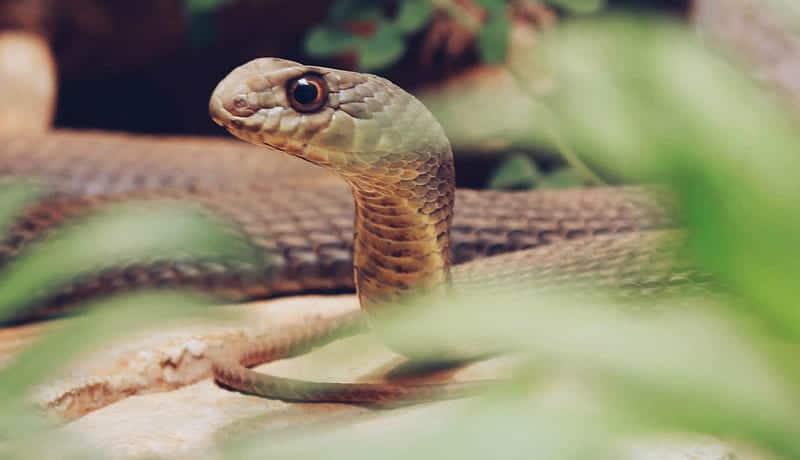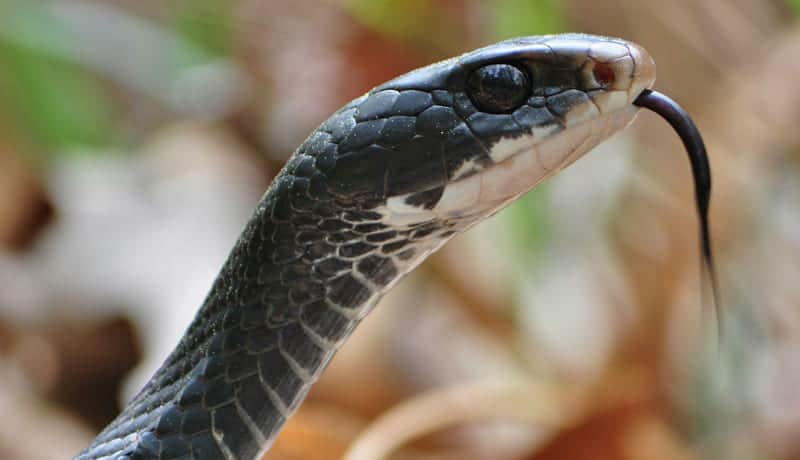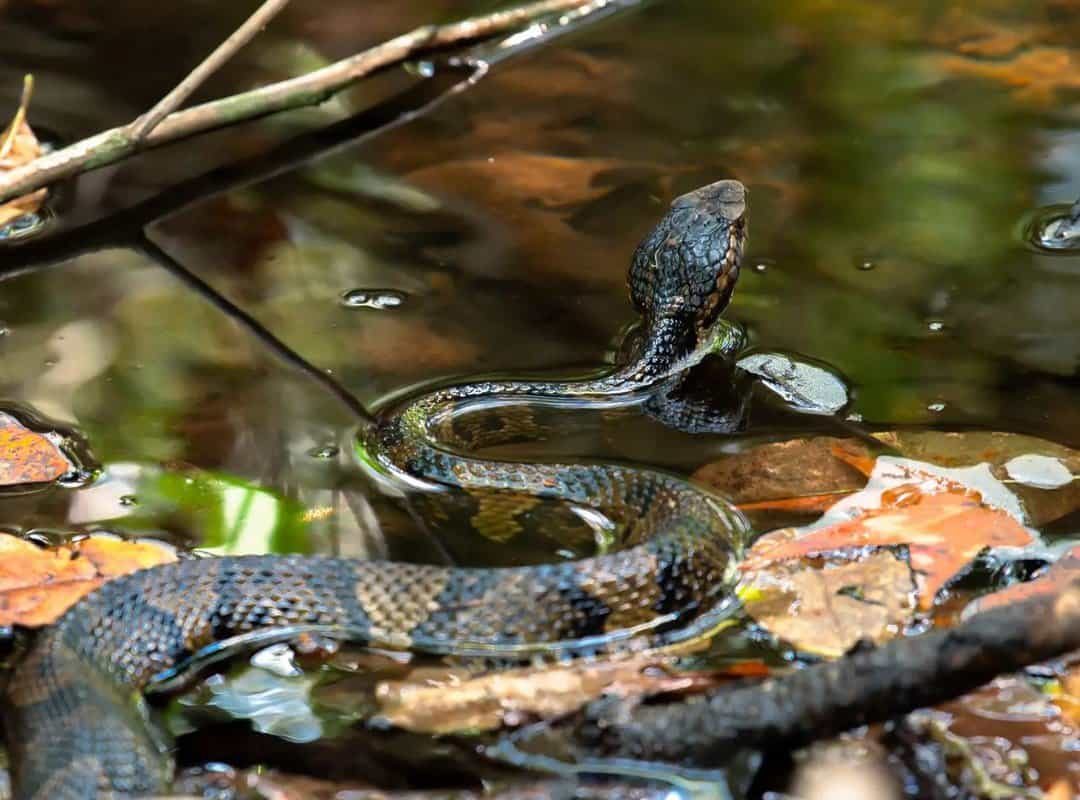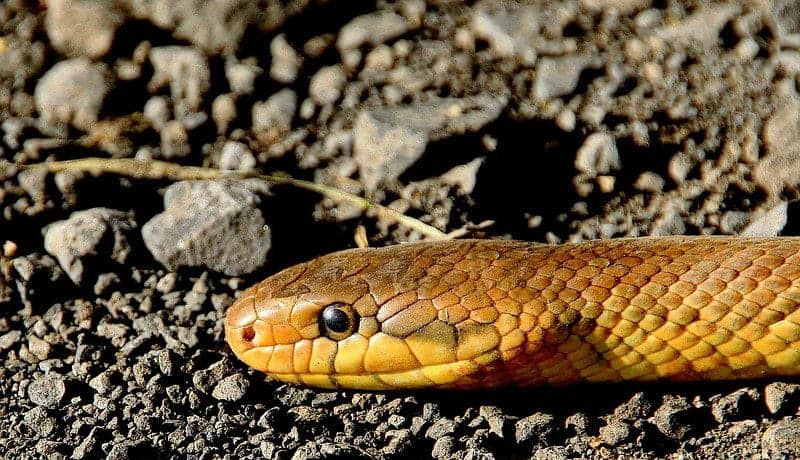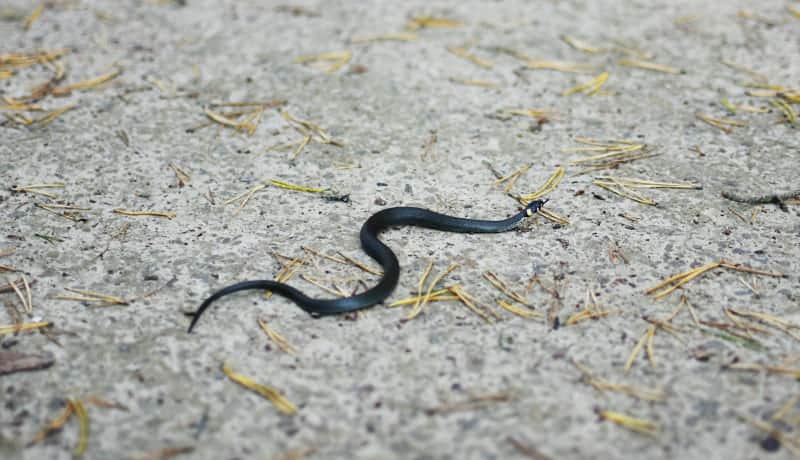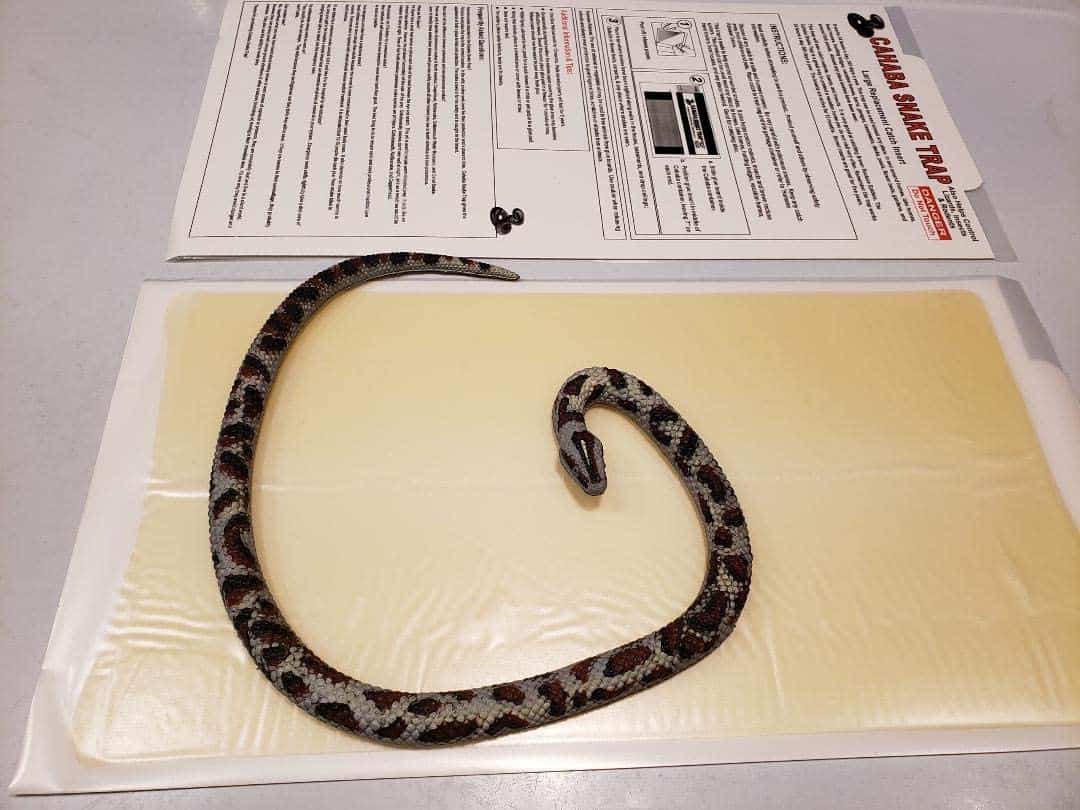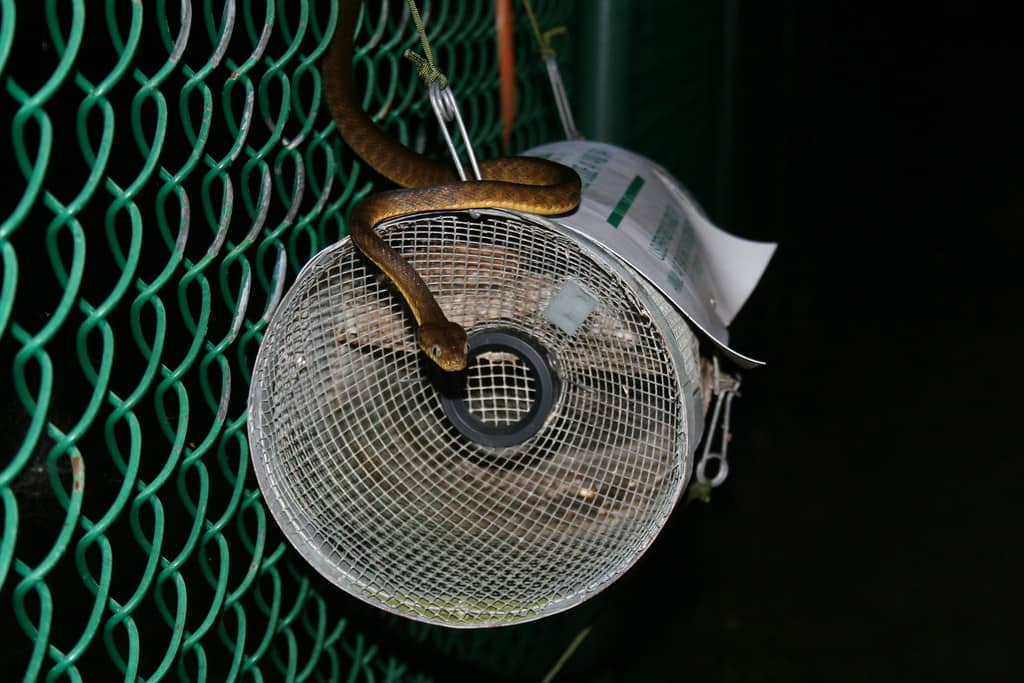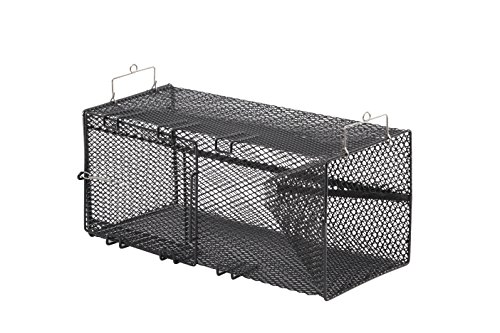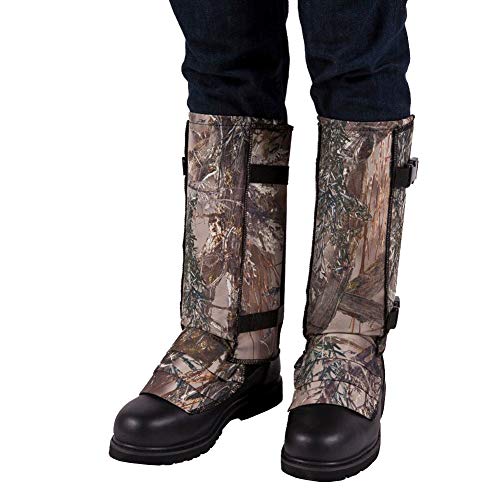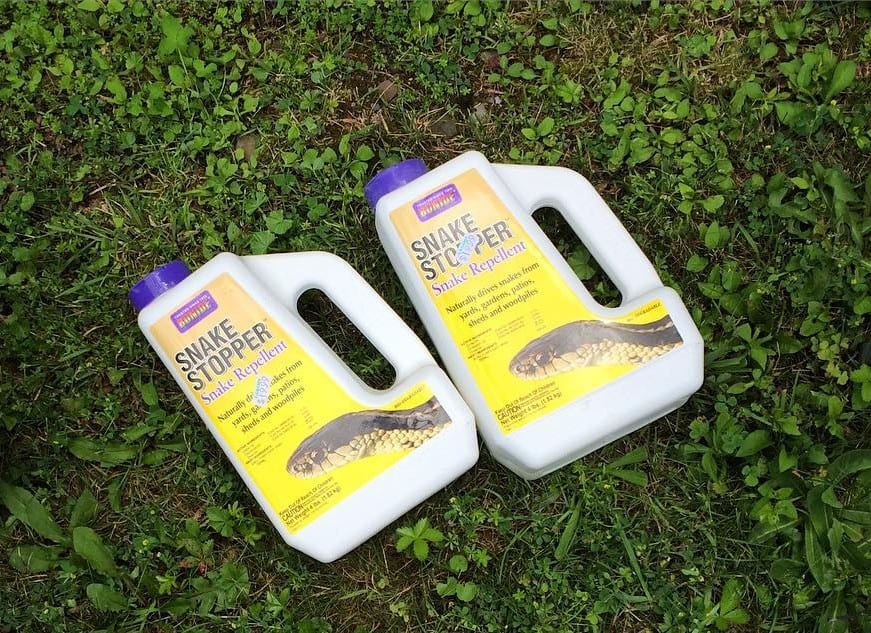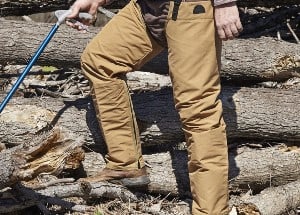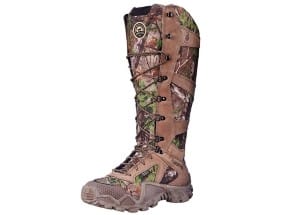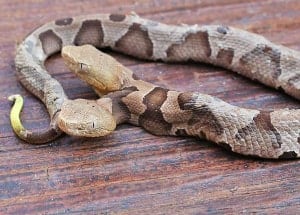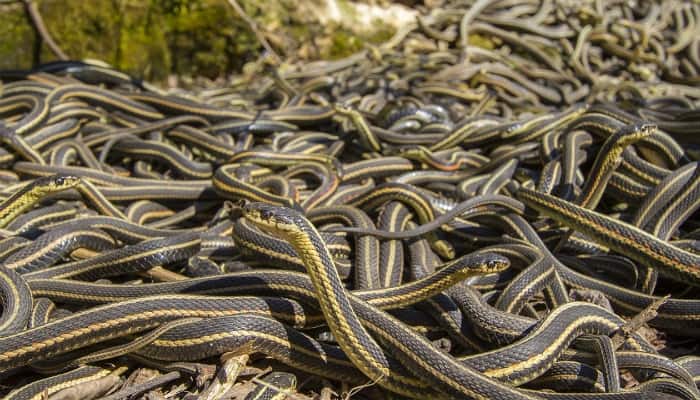Few animals raise as many irrational fears in us humans as snakes do. It’s safe to say that most people are terrified at the thought of running into a slithering reptile in their property.
Unfortunately, chances are high that you’ll find one wriggling in your backyard sooner or later unless your area is completely snake-free, so be prepared to chase the unwelcome guest away.
Luckily, there’s quite a number of safe and reliable anti-snake solutions. Different approaches can be used when it comes to snake safety, from actually keeping the wriggly animals off your territory to simply preventing bites. It might be a good idea to combine several techniques, too.
Before you go on to read my snake control tips, however, it’s worthwhile to get to know your enemy.
Snake Facts
First of all, not all snakes are dangerous. Most species are referred to as nonvenomous snakes since their saliva doesn’t contain toxins to kill/digest prey. One example is the so-called garter snake (read the US Snakes section for details).
This doesn’t mean that they will never bite you; some may attack if they feel threatened. The consequences, however, are usually limited to irritation and/or itchiness, although rare cases of allergic reactions have been reported.
Venomous species, however, are more of a concern. These include cottonmouths, timber rattlesnakes, and many more. There are about 21 dangerous snakes in the US alone, mostly attacking outdoor workers like gardeners or roofers and hikers. Venomous snake bites can be deadly (although this doesn’t happen often) unless an anti-venom is used.
The life cycle of a snake can vary depending on the species, although the average lifespan is 10 to 15 years in the wild. When it comes to breeding, all snakes fall into two major categories. While some species lay eggs, others give birth to live young.
The breeding seasons differ depending on the weather conditions, though nothing can prevent snakes from breeding all-year-round in a warmer climate.
As for snakes’ feeding habits, they are carnivores. The key factor that determines the size of their prey is, quite naturally, their own body size. Smaller species like to feast on insects, birds and bird eggs, as well as tiny mammals like mice, while large serpents like the reticular python will gladly gulp down a dog if they are lucky.
US Snakes
I’m going to briefly cover the most wide-spread snakes of North America, but be sure to check the local lists for your specific area since a lot depends on the climate.
The most common non-dangerous species include the following:
The gray rat snake, also known as the chicken snake, a rather big serpent that can be about 1.5-meter long, with a blotch skin pattern. It mostly occurs in the woodsand has good climbing skills.
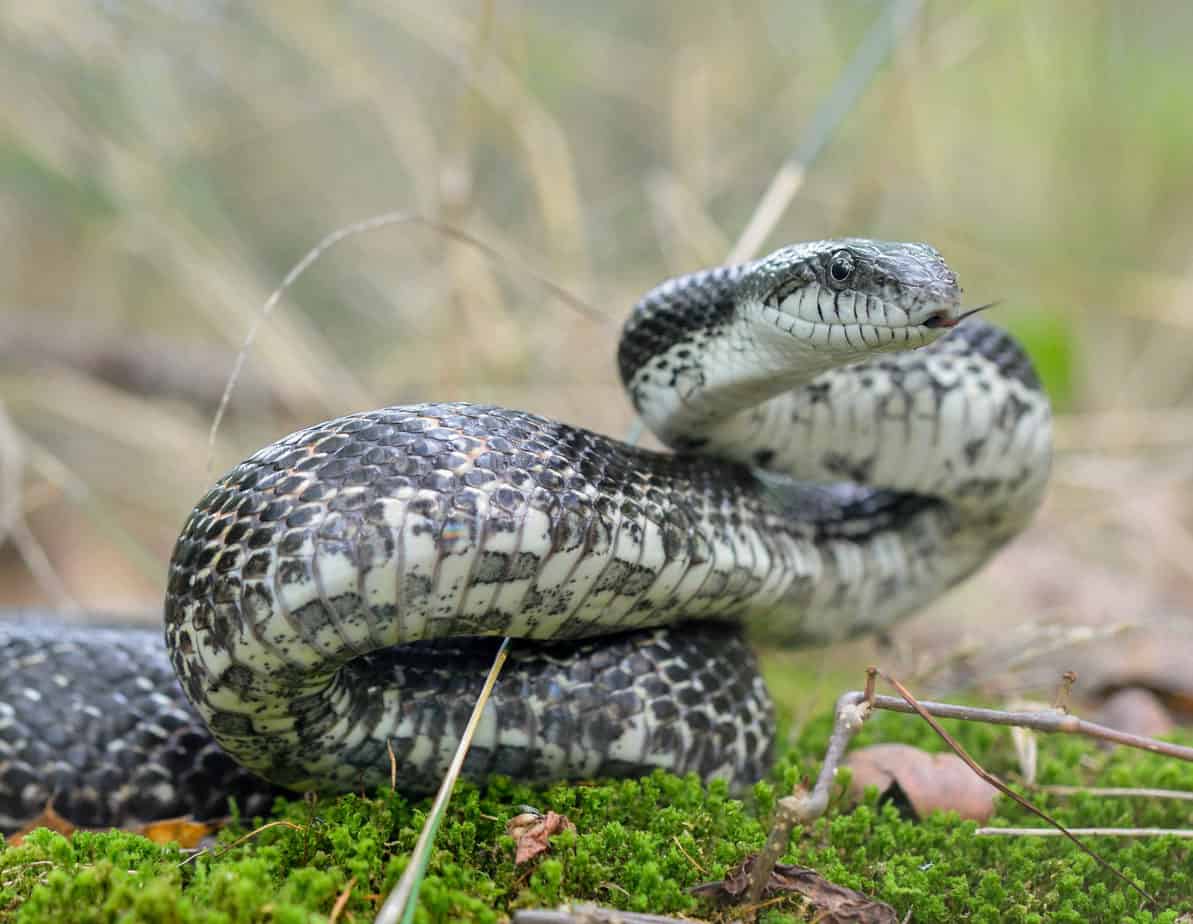
Grey Ratsnake
The common garter snake, easily recognized by yellow stripes that stand out against its darker back, about 50 cm long. It’s very wide-spread across the US. Although its saliva does contain mild venom, it’s not lethal to humans. It also goes under the name of garden snake, which means you’re quite likely to encounter one.
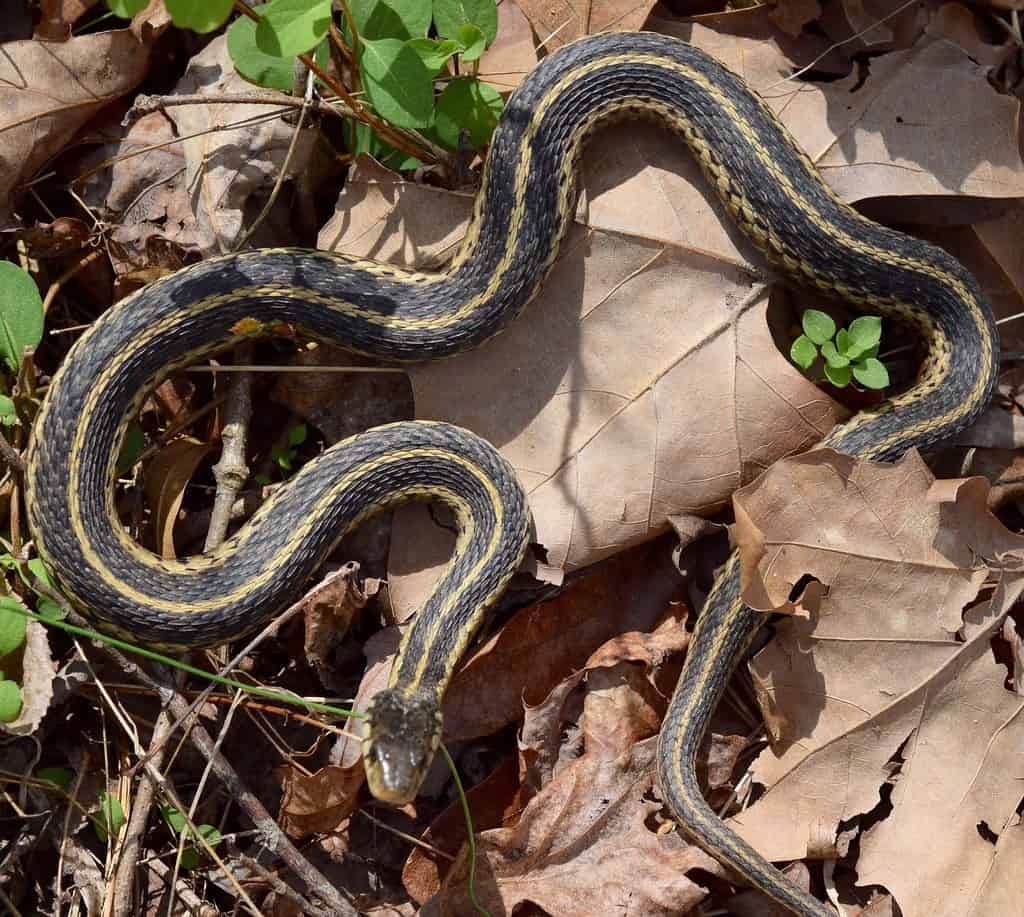
Common garter snake
The black racer, a fast-moving serpent approximately 1 to 1.5-meter long, all black except for the chin, which is white, causing it to resemble the deadly cottonmouth (see below). This species is mostly found in the South.
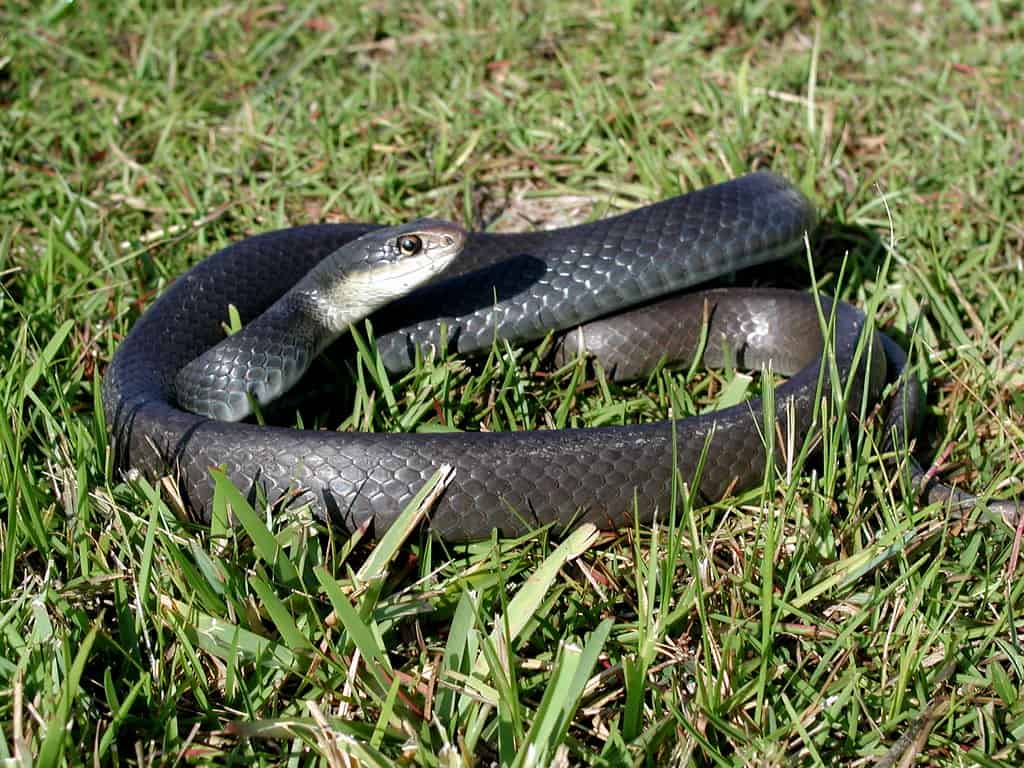
Black racer
The indigo snake, usually between 1.5 and 2.3-meter long, a blueish black from head to tail. Although big, this species is harmless to humans and is even recognized as endangered, while remaining more or less common in the eastern part of the country.
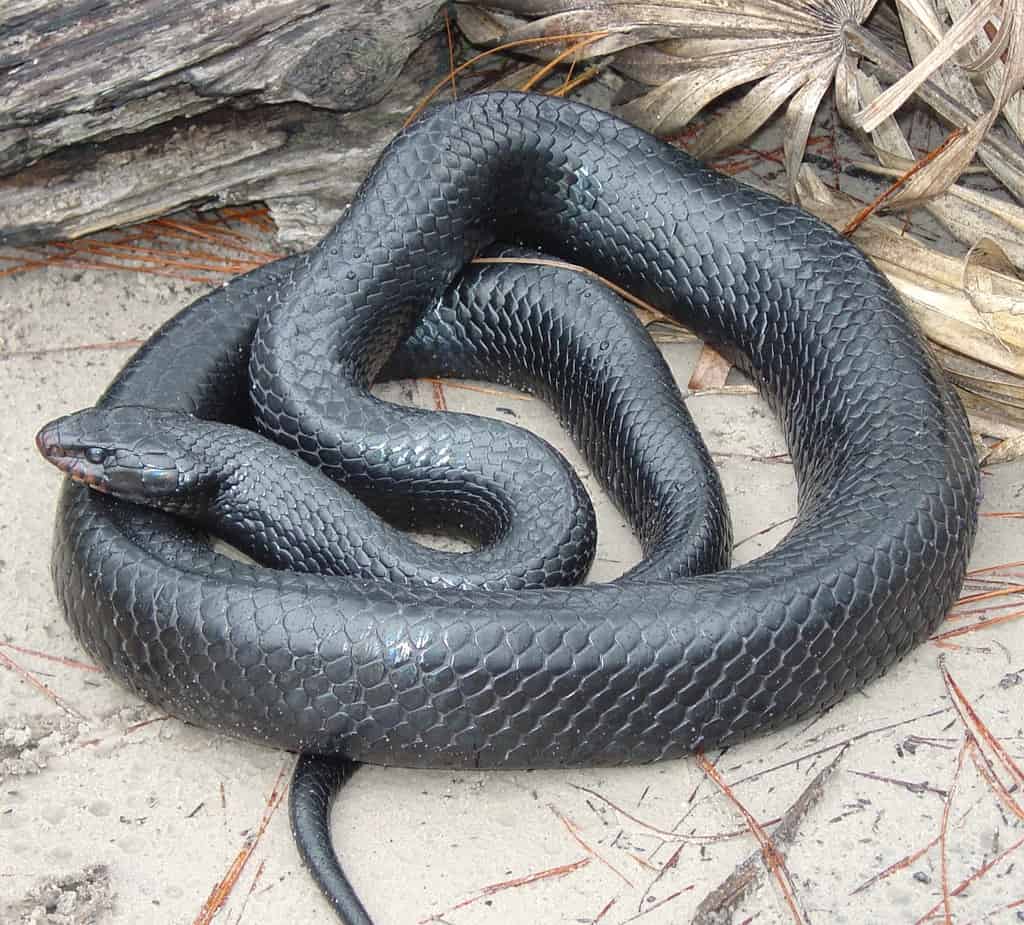
Indigo snake
The ringneck snake, a slightly venomous but generally harmless species found throughout the US easily recognized by a yellow/orange ring around its neck.
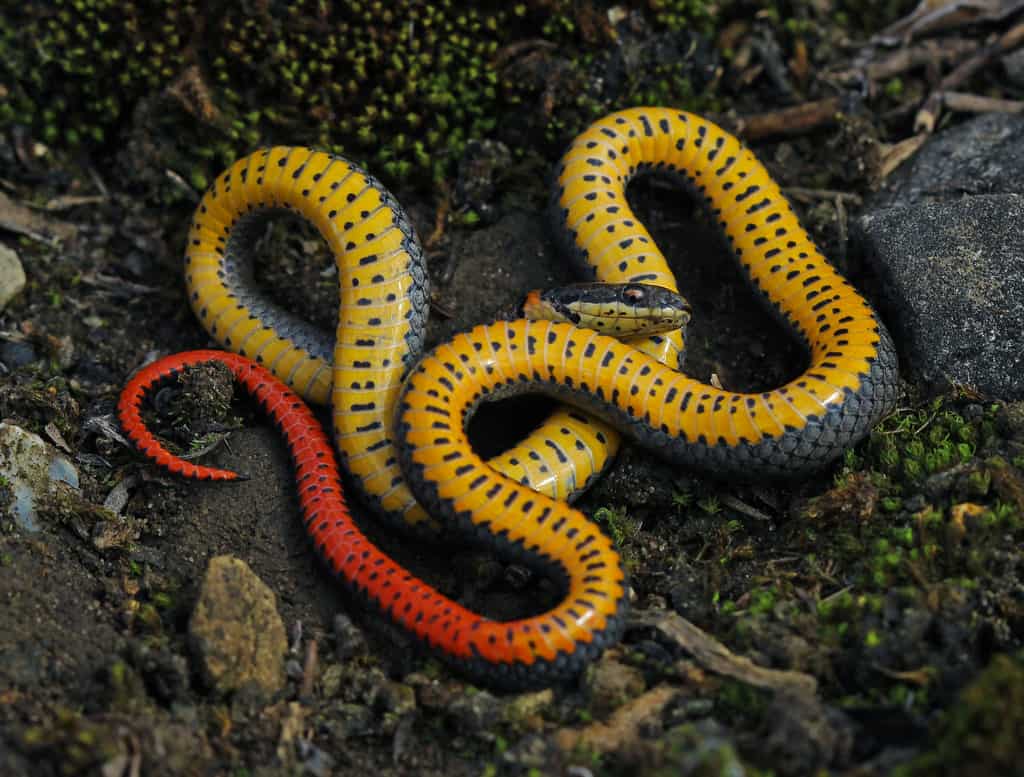
Ringneck snake
The coachwhip, also known as the whip snake, a long (up to 2 m), small-headed species of varying, mostly inconspicuous color that occurs from coast to coast.
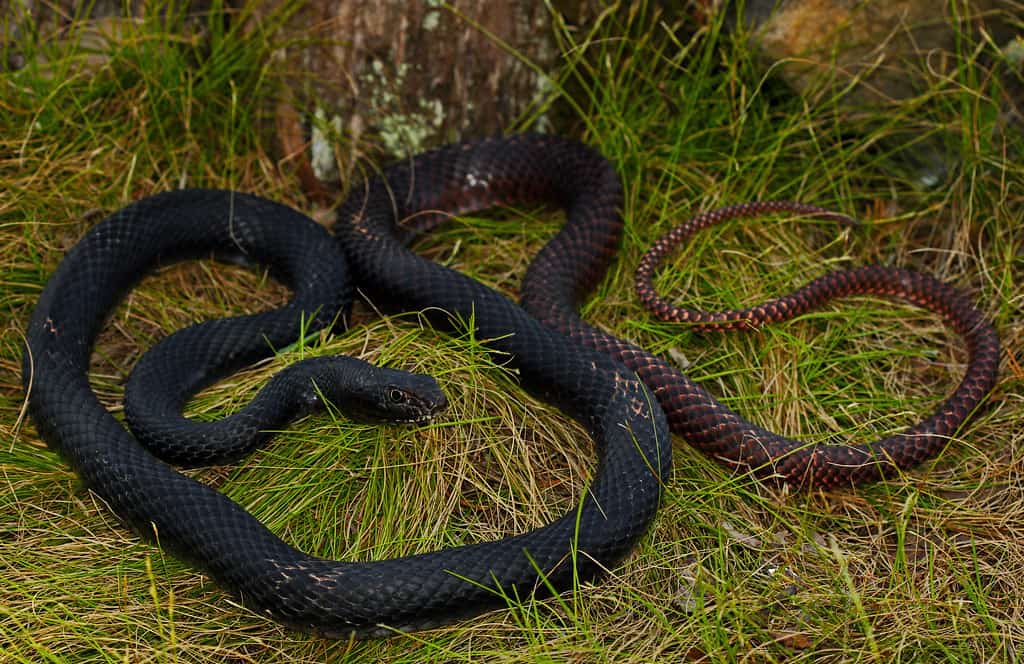
Coachwhip
Note that some of the above do carry venom in their fangs, which doesn’t make them dangerous or lethal to humans (although they can pose a threat to much smaller mammals such as rodents). Some North American snakes that you really don’t want to mess with are:
The coral snake, classified into eastern and western, both boasting brightly colored black-and-red striped skin with thinner yellow stripes in between. Luckily, this species is primarily nocturnal, meaning it’s unlikely to attack during the day.
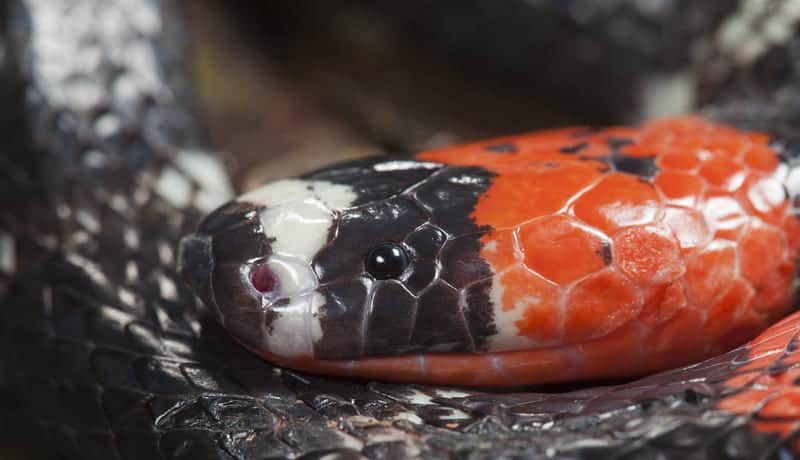
Coral snake
The copperhead snake, a moderately sized (mostly below 1 m) reptile with a distinct broad, copper-red head (hence the name), grayish-brown with darker brown spots. This species is probably the most likely to bite humans but is not the deadliest.
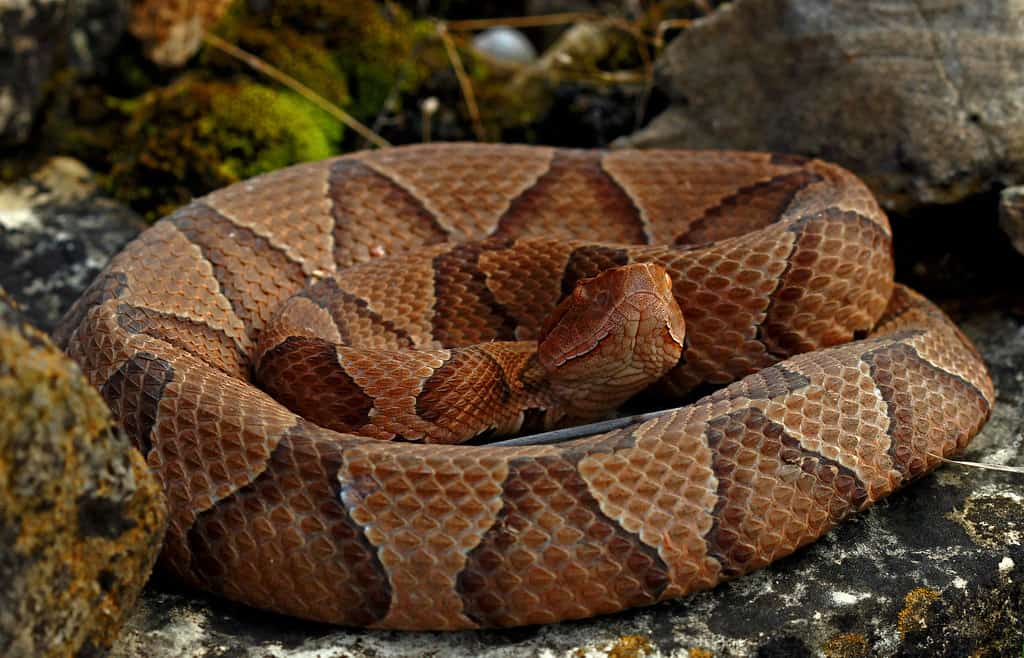
Copperhead snake
The cottonmouth, also referred to as the water moccasin, an aggressive species that tends to assume a threatening pose whenever in danger, opening its bright-white mouth that then resembles a piece of cotton.
It’s a semiaquatic viper, which means it’s mostly found in or near water. Its body is usually totally black except for the head markings, though crossbands have been found in rare cases.
Cottonmouth
The Eastern diamondback, the largest rattlesnake found across the globe, measuring up to 1.7 m on average, with a brownish body bearing a pattern of darker diamonds. It’s habitat is quite diverse.
Since it’s a rattlesnake, it has a rattle on its tail that can be used to produce characteristic noise, supposedly to threaten potential predators. Contrary to a popular myth, the snake doesn’t have to use its rattle every time it wants to strike.
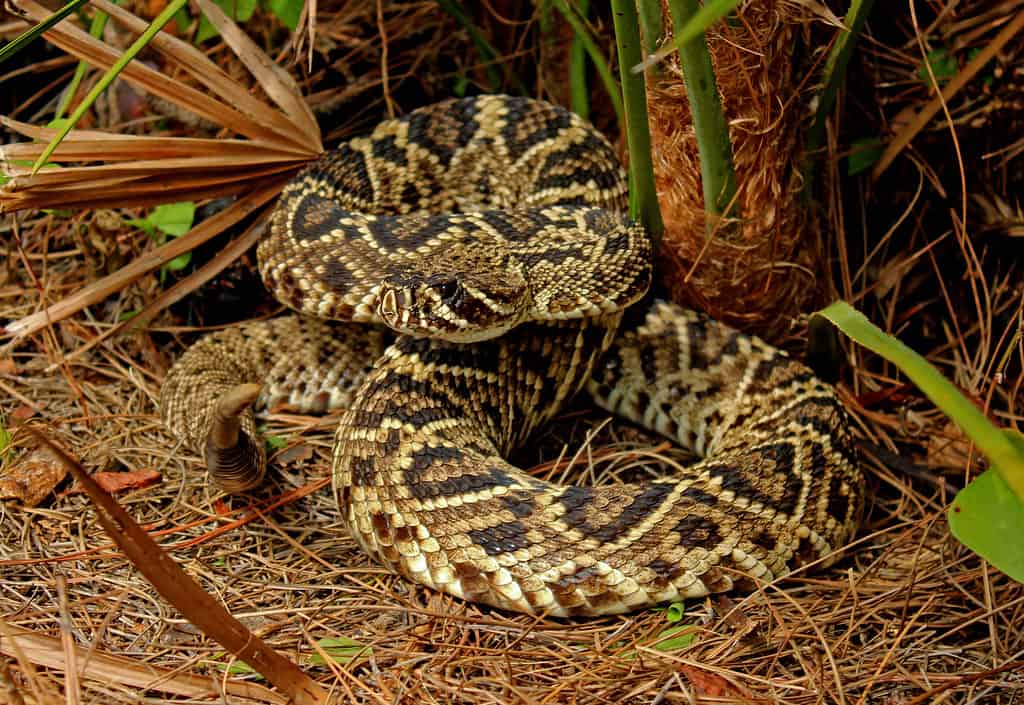
Eastern Diamondback
The Western diamondback, a smaller cousin of the above species, light-brown with the diamonds outlined in cream, notorious for producing large amounts of highly toxic venom. Just like its Eastern relative, this serpent has a tail rattle.
It also has a bad reputation for being extremely aggressive with a tendency to bite. Although it inhabits areas with various conditions, this species shows a preference for the desert and rocky, mountainous regions.
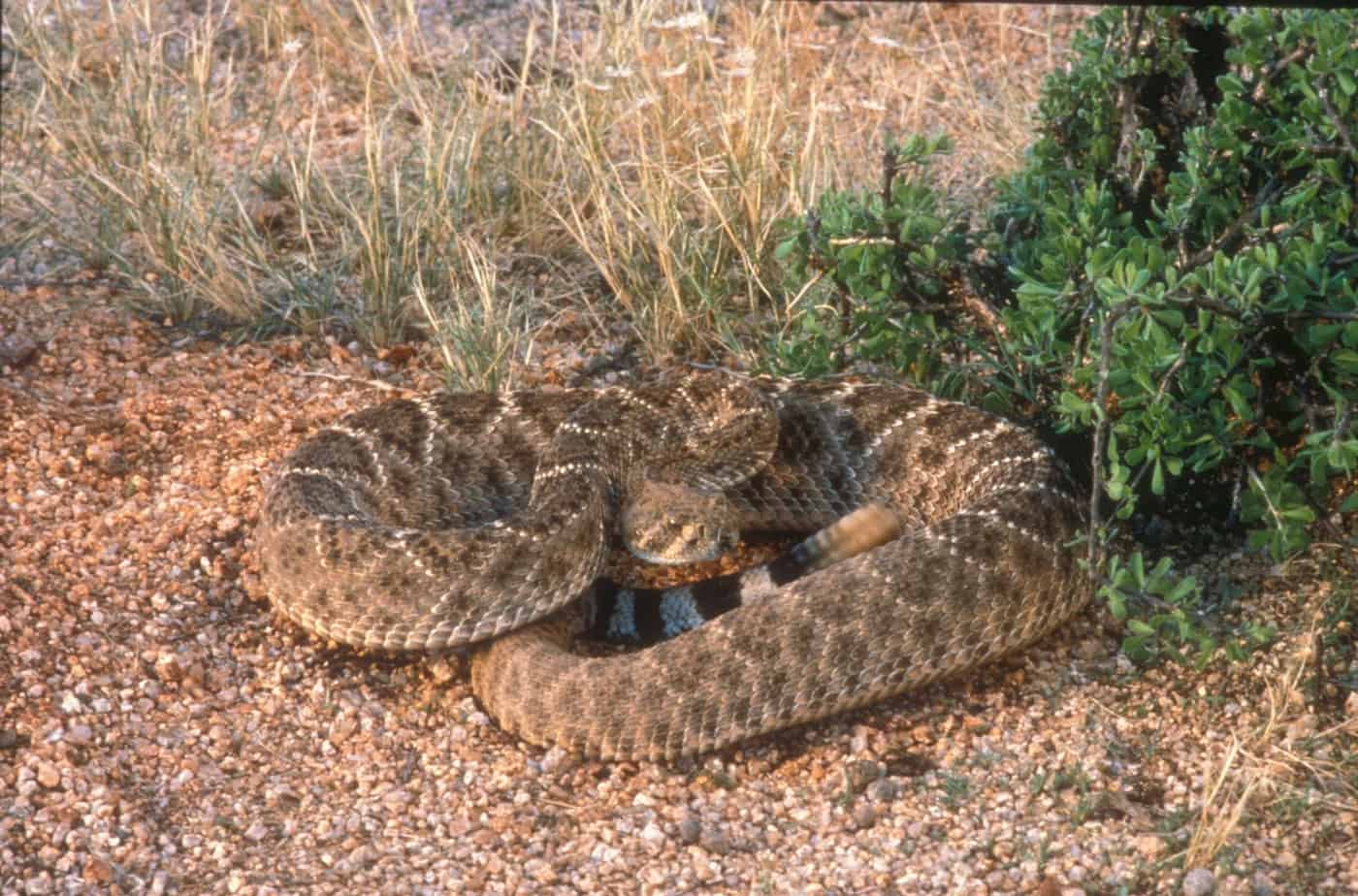
Western diamondback
The timber rattlesnake, another member of the deadly family, rather common in the northeastern part of the country. This species normally measures up to 1.2 meters and doesn’t have the diamond pattern that’s characteristic of its abovementioned relatives.
Instead, it bears dark brass bands around its cream-colored body. Melanistic individuals are very common, exhibiting solid black coloring. Although widespread in the US, this species isn’t unlikely to bite unless clearly provoked, mostly using its loud rattle to keep humans away.
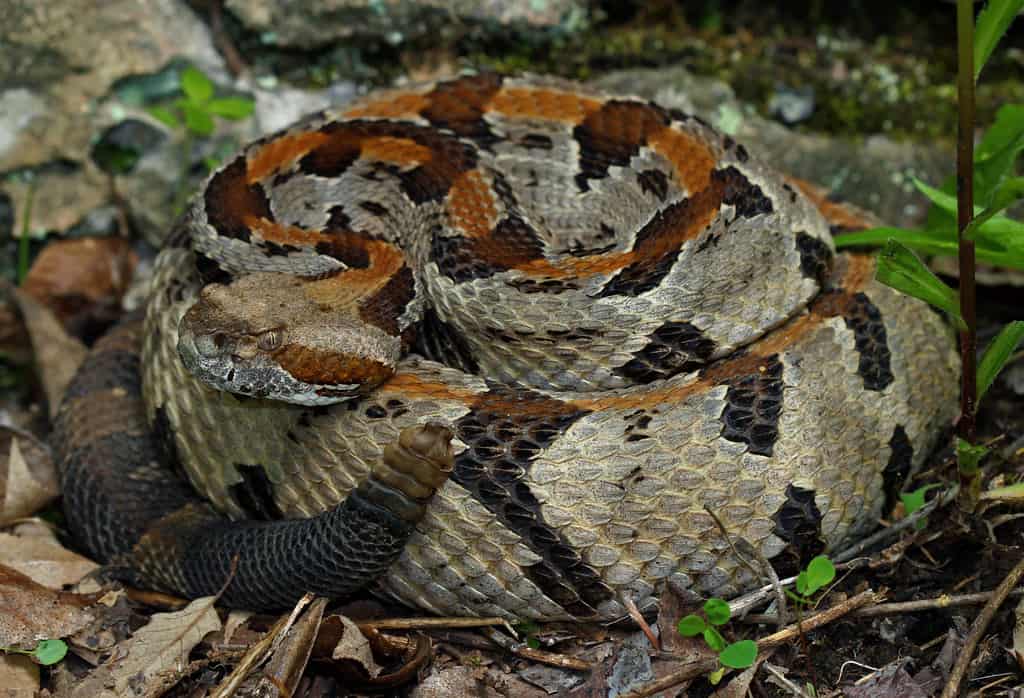
Timber rattlesnake
The Mojave rattlesnake, yet another representative of the rattlesnake group, relatively small but extremely aggressive and lethally toxic. This species is mostly found in sandy areas with sparse vegetation.
So, What’s the Best Way to Get Rid of Snakes?
If you’ve spotted a serpent wriggling in your garden, your first step should be to figure out whether it’s dangerous. If the guest turns out to be venomous, the best way to proceed is by calling your animal control authorities or, alternatively, a commercial pest control company that will take care of every step from trapping the unwanted visitor to snake nest removal (if any).
The best way to deal with harmless species is probably to find out what attracted them in the first place. Like with most pests, it’s usually easier to make your territory unappealing to them than to implement large-scale snake removal strategies.
How to Get Rid of Snakes by Tidying Up
First of all, make sure that your garden is as clean as possible, paying special attention to potential hiding spots for snake prey like mice, rats, and insects. This means that heaps of fallen leaves as well as overgrown bushes, massive weeds, and wood piles are unwelcome.
Apart from the little animals that are essentially inherent to having a garden, pesky creatures like moles and rodents might appeal to a larger reptile’s taste. Since most snakes prefer cool, damp areas, it’s in your best interest to keep your place as dry as possible. Avoid overwatering your plants and leaving the pots outside to dry.
Remember that snakes are sneaky creatures that will gladly use an opportunity to get indoors, so inspect your house for any gaps and be sure to get rid of snake holes as soon as possible. Special attention should be paid to vents since they are easy to get into unless screened.
Don’t forget to stay safe while getting rid of snakes in your property by wearing appropriate snake-proof shoes, or regular boots paired with snake gaiters or chaps for extra protection. Since our legs are the most common target for biting snakes, it’s essential that we cover the area with a puncture-resistant material.
Regular jeans won’t do the job, so consider purchasing a pair of specialized leggings that a snake can’t bite through. Snake chaps are an even safer option as they cover your whole leg up to the thigh. However, this kind of garment can be pricey, while it’s not very likely that a snake will attack this high.
Now that your home doesn’t look very welcoming, you may be lucky to never see the wriggling visitors again. Yet, these measures don’t guarantee long-term success as such, especially if the snakes have a nest somewhere on your property. This might mean you need to go nuclear with specialized traps and snake repellents.
What to Use to Get Rid of Snakes: Deterrents and Traps
Please mind that snakes play an important part in the ecosystem. For example, they are good at keeping some pests in check. There are large but non-dangerous species that can eat deadly snakes, too. That’s why I always advise against snake extermination techniques such as poison.
If you’ve been wondering what kills snakes in the yard, consider removing live serpents instead. Here’s how you can do it.
Snake Repellents
Snakes repellents are one way to keep the slithering creatures off your territory. Most rely on strong, offensive smell, while others generate ultrasound tones that the reptiles find frightening. Products in the latter category are usually versatile, also deterring some rodents and even stray cats.
When it comes to smell, snakes are very much like other animals. What keeps snakes away are intense odors like those of cloves and garlic, vinegar, and, of course, ammonia. Naphthalene is also a very common ingredient in commercial snake repellents.
Snake Traps
Another way to send the slithering visitors packing is by trapping them. As soon as the reptile is inside the trap, you need to relocate it somewhere where it won’t be a nuisance to you or other people.
Snake traps vary in shape and principle of operation. The most common types include garden variety minnow traps, normally used to catch small fish, glue traps, and cage traps.
Glue traps are very simple to use as they are essentially a smooth pad with adhesive material applied over it to prevent the snake from moving as soon as it contacts it. Although extremely efficient and affordable, this is not the most humane way to deal with pests, as it often means slow suffocation and injuries caused by attempts to wriggle out of the trap.
Be careful when using this kind of trap near children and pets as they tend to get stuck really often. The remedy is vegetable oil of any kind.
Cage traps are less inexpensive but way less cruel. What you do is put a bait inside and wait for the snake to enter looking for it. When it’s trapped, carry it safely to a far-away location and release it according to applicable legislation.
Minnow traps are similar to the cage variety but use conical funnels as entry points — it’s way easier to get in than to go out.
Best Snake Control Remedies
1. Frabill Minnow Trap: Best Humane Snake Trap
Specifications:
- Material: Blend
- Number of Pieces: 1
- Item Weight: 2 Pounds
- Item Dimensions LxWxH: 18 x 8 x 8 inches
- Target Species: Crawfish or Minnows
Unlike most minnow traps, this model has a box shape and handles attached to it, making it easy to carry the trapped reptile away. It also has a door that’s easy to open for this purpose as well as for placing a bait.
The material is heavy-duty vinyl dipped steel resistant to saline water. The mesh is painted black, which definitely makes it less conspicuous. It’s 8 x 8 x 18”, which is more than enough for most species as they will coil eagerly inside. What happens is that the snake just can’t find its way out.
I find this to be a very humane anti-snake solution as it doesn’t really harm the reptile. It’s also safe for pets and humans of all ages.
| Pros: | Cons: |
|
|
2. Catchmaster Baited Rat, Mouse and Snake Glue Traps: Best Snake Glue Trap
Specifications:
- Material: Plastic
- Number of Pieces: 12
- Item Weight: 8 ounces
- Item Dimensions LxWxH: 3.85 x 0.5 x 0.43 inches
- Target Species: Cockroach, Cricket, Mouse, Rat, Snake, Spider
The first thing you notice about glue traps is how affordable they are, especially when sold in packs like this item. This is really a welcome bonus since you’ll probably need several to make double sure.
The traps are essentially trays covered in glue that will fix the snake on it. They are also quick and easy to use. This trap doesn’t immediately kill the animal, so be prepared to deal with it as soon as you hear the noise. What makes this glue trap stand out among similar items is that it comes baited, which will spare you time and effort.
You should be aware that this is not a specialized snake solution, so don’t use these traps if you have small pets like rodents running about the house as they might get trapped. According to the label, the adhesive used is non-toxic.
| Pros: | Cons: |
|
|
3. Crackshot Men’s Snake Bite Proof Guardz Gaiters: Best Snake Bite Gaiters
Specifications:
- Fabric Type: 100% Other Fibers
- Care Instructions: Hand Wash
- Item Volume: 325 Milliliters
- Product Dimensions: 20 x 6 x 6 inches
- Water repellant
- Windproof
You’ll definitely need lower leg protection when dealing with snake infestation, and this is the model I highly recommend. Made by a specialized US company, they are puncture resistant to the point of being snake proof.
Another advantage I noticed immediately when I tried these on is how lightweight they are compared to other models. They also fit your leg really well due to the fact that they come in six sizes, while most brands only offer two at best. These gaiters feature adjustable straps to ensure perfect fit as well.
Most importantly, they ensure excellent coverage of the shoelace area, preventing bites in the foot. This makes them really versatile in terms of footwear.
| Pros: | Cons: |
|
|
4. Dr. T’s 28 lb. Snake-A-Way Snake Repelling Granules: Effective Naphtalene-Based Snake Repellent
Specifications:
- Active Ingredients: Naphthalene (7%) and Sulfur (28%)
- Item Form: Granules
- Item Weight: 4.15 pounds
- Package Dimensions: 3.3 x 8.4 x 12 inches
- Target Species: Snakes
These granules contain 7% naphthalene and 28% sulfur, a combination that will effectively repel most snake varieties that are likely to appear in your backyard, venomous and harmless alike. You should consider this option if you’ve been wondering how to get rid of garden snakes without harming them, since the granules simply deter serpents with their offensive smell.
This product is quite simple to use. All you need to do is place the granules in bands around your perimeter. The width of each band depends on what species you’re dealing with. For instance, rattlesnakes are less easy to chase away than garter snakes. Alternatively, you can sprinkle the whole area. Don’t forget to wear gloves in either case!
The granules are to be used with caution around children and pets as they contain naphthalene
| Pros: | Cons: |
|
|
5. Bonide Products INC 916132 875 Snake Stopper: Best Snake Granular Repellent
Specifications:
- Active Ingredients:
- Item Form:
- Item Weight:
- Package Dimensions:
- Target Species: Snakes
You’ll probably find this product useful if you’ve been wondering how to get a snake out of the garage without going nuclear with naphthalene. The three active ingredients here are clove oil, cedar oil, and cinnamon oil, enhanced by sulfur.
This is an eco-friendly, biodegradable product that poses no danger to human and pet health. It won’t harm the snakes, either, as it works simply as a smell-based deterrent. It’s safe to use in children’s play areas as well as indoors. The only disadvantage of the granules is that you can’t use them near crops intended for food.
| Pros: | Cons: |
|
|
FAQ
What Are Most Common Snake Hiding Places?
Snakes love places like piles of wood and other material; they also hide around window frames, near water pipes, and in dense shrubs or tall grass. Deep pavement cracks can be an issue, too.
Can Certain Plants Keep Snakes Away?
Snakes tend to avoid strong-smelling plants like garlic, wormwood, and marigold. Lemongrass is also an effective natural snake repellent as it releases pungent citronella oil. Although widely considered a weed, mugwort can do a good job of keeping snakes away.
Do Mothballs Keep Snakes Away?
Mothballs are another way to deter snakes due to naphthalene in their formula. Please use mothballs with caution since naphthalene can be toxic to humans of all ages as well as pets, and little children might swallow a mothball by accident!
How to Get Rid of Rattlesnakes?
Apart from the general tips that apply to all species, I advise contacting local wildlife control authorities since rattlesnakes are highly venomous snakes and dealing with them on your own can be dangerous. If you choose to use traps, however, be sure to wear protective gloves and clothing.
When to Call a Snake Exterminator?
It’s best to contact a snake control service whenever you aren’t sure that the reptile you’re dealing with is completely safe. Remember that it may be hard to identify the species correctly, so don’t take chances if there are any dangerous snakes in your area!
Summing It Up
Whether venomous or totally harmless, snakes are viewed by most as unwelcome guests. However, they do play an important role in the ecosystem and are thus entitled to humane treatment.
There are a number of approaches to chasing the reptiles away without harming them. Two major tactics are to use intense repelling smells or traps. Which to choose depends entirely on your preferences and budget, but remember that you’ll have to somehow deal with the snake when it’s trapped, so plan ahead. I also don’t recommend waging war at deadly species and suggest that you entrust the case to specialized authorities or pest control experts.
Since protective clothing is part and parcel of snake safety, consider purchasing a pair of snake gaiters or chaps whenever you’re likely to encounter some of the slithering creatures.
Are there any venomous snakes in your area? Have you ever come across one? Feel free to share in the comments section!
References:
- Nonvenomous Snakes (National Park Arizona):
https://www.nps.gov/sagu/nonvenomous-snakes.htm - Venomous snake bites: clinical diagnosis and treatment (National Center for Biotechnology Information, U.S. National Library of Medicine):
https://www.ncbi.nlm.nih.gov/pmc/articles/PMC4393627/ - Snakes of North America (University of Pittsburgh):
https://www.pitt.edu/~mcs2/herp/SoNA.html - 12 Ways to Stop Snakes From Slithering Into Your Yard (Utah State University):
https://extension.usu.edu/news_sections/gardening/12-ways-to-stop-snakes-from-slithering-into-yards - Snake Safety (Savannah River Ecology Laboratory (University of Georgia):https://srelherp.uga.edu/snakes/snake-safety.htm
Contents
Why You Should Trust Pest Control Hacks?
We know that pests are nasty neighbors, and it can take months to eliminate them without the right approach. Our experts use their own experience to compile articles and guides that are introductory and informative. Our authors’ opinions are independent and based on the results of practical testing of pest control tools. We do not notify manufacturers of testing of their products and do not receive payment from them for posting their items. Also, our texts are never submitted to company representatives for proofreading before placement. On the site, you will find exclusively objective ratings and reviews.

